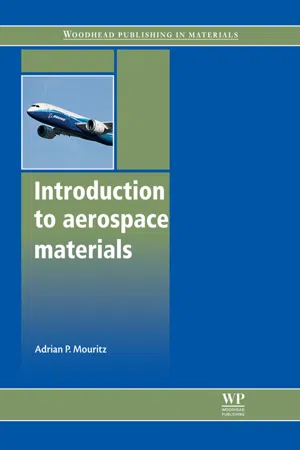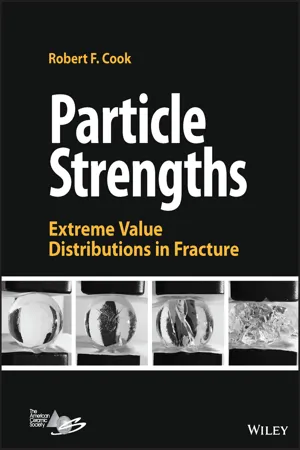Technology & Engineering
Grain Size Strengthening
Grain size strengthening refers to the phenomenon where the strength of a material increases as the grain size decreases. This occurs because smaller grains hinder the movement of dislocations within the material, making it more resistant to deformation. By refining the grain size through processes such as cold working or heat treatment, the material's strength and hardness can be enhanced.
Written by Perlego with AI-assistance
Related key terms
Related key terms
1 of 4
Related key terms
1 of 3
3 Key excerpts on "Grain Size Strengthening"
- eBook - ePub
- Adrian P Mouritz(Author)
- 2012(Publication Date)
- Woodhead Publishing(Publisher)
Fig. 4.19 shows the effect of average grain size on the yield strength of steel. Reducing the grain size also has the additional beneficial effects of increasing the ductility, fracture toughness and fatigue life. Strength increases because the distance that dislocations must travel through a grain core to reach a grain boundary decreases with the grain size. Dislocations are more likely to reach a boundary, and thereby strengthen the metal, when the grain size is reduced.The grain size is related to the yield strength according to the Hall–Petch relationship:4.19 Effect of grain size on the yield strength of steel.σ y=σ o+ kd− 1 / 2whereσyis the yield strength and d is the average diameter of the grains; k is a material constant representing the slope of theσy– d − 1/2 plot; so is called the friction stress, and is the intercept on the stress axis (Fig. 4.19 ). σ o is a material constant that defines the stress required to move dislocations in a single crystal without a grain boundary (d − 1/2 = 0). The Hall–Petch relationship is used by engineers to calculate the grain size necessary to achieve a required level of strength. The Hall–Petch relationship is accurate for metals with a grain size between about 1 μm and 1 mm, but is not valid for materials with larger (> 1 mm) or finer (< 1 μm) grains.Theoretically, metals can be made infinitely strong if their grains are infinitely small. In reality, this is impossible because the lower limit on grain size is a single unit cell of the crystal. The finest grain size in most aerospace alloys is about 1 μm. Smaller than this, the length of the dislocation approaches the size of the grain.The grain size of aerospace metals is reduced to the size range of about one to several hundred micrometres using various techniques, including rapid cooling of the molten metal during solidification casting, addition of grain-refining elements (called inoculants), and thermomechanical processing. The control of grain size is explained in more detail in Chapters 6 and 7 - eBook - ePub
Structural Geology
The Mechanics of Deforming Metamorphic Rocks
- Bruce E. Hobbs, Alison Ord(Authors)
- 2014(Publication Date)
- Elsevier(Publisher)
The two types of behaviour are illustrated in Figure 13.16. We refer to situations where an increase in grain size leads to a decrease in strength as grain size weakening (Figure 13.16(c)). If an increase in grain size leads to an increase in strength, we refer to Grain Size Strengthening (Figure 13.16(f)). In some literature (Hansen, 2004), these two contrasting effects are referred to as grain boundary strengthening and grain boundary weakening, respectively. Although experimental data are relatively scarce for minerals and rocks (the emphasis over the past 40 years or so has been on ‘steady state’ creep behaviour), the early experimental work of Griggs et al. (1960, Figure 30) demonstrated the Hall–Petch effect for calcite rocks: fine-grained (10 μm) Solenhofen limestone is stronger than medium-grained (10–1000 μm) Yule marble which in turn is stronger than 10-mm sized single crystals of calcite (Figure 13.17). In these experiments, the strain rates are quite fast (10 − 4 –10 − 5 s − 1) and hence some fracturing may have occurred. The effect is probably due to the difficulty of propagating twinning across grain boundaries (Rutter et al., 1994). Similar grain size weakening effects are reported for calcite-rich rocks by Rutter et al. (1994) and by Renner et al. (2002) for strain rates down to 10 − 7 s − 1. This grain size weakening effect as a function of strain rather than stress is a much neglected topic in metamorphic geology. Drury (2005) has incorporated the effect of dislocation-dominated grain size-sensitive flow into deformation maps for olivine where he refers to the effect as grain size-sensitive power law creep and another example for calcite-rich rocks is given in Figure 13.15 - eBook - ePub
Particle Strengths
Extreme Value Distributions in Fracture
- Robert F. Cook(Author)
- 2023(Publication Date)
- Wiley-American Ceramic Society(Publisher)
. Solid line is an empirical fit from a simplified bridging model.The considerations above of grain-based microstructural effects on strength imply that the effects are well understood and simply modeled within the SIF fracture framework. From the practical viewpoints of design, fabrication, and selection of polycrystalline microstructures for optimized strengths of particles, the guidance is clear. Large-grained microstructures with weak grain boundaries will convey significant flaw tolerance to particles (extended strength plateaus) but at the expense of reduced strengths. The enhanced strengths associated with enhanced long-crack toughness are unlikely to affect common particle mechanical performance. Large rock particles composed of many grains are a possible exception. Small-grained microstructures with greater grain boundary integrity will generate particles with greater maximum strengths but at the expense of reduced flaw tolerance (contracted strength plateaus). The enhanced strengths associated with enhanced short crack toughness are also unlikely to to affect common particle mechanical performance. Small ceramic particles composed of very few grains are a possible exception. The effects of particle size D on microstructurally controlled strength can be approached in several ways. At the simplest level of scaling is the expectation that large particles contain large grains and vice versa (e.g. mineral ore vs grinding media) and thus. The resulting strength behavior follows Figure 13.18 and thus. The next level of scaling is if the parametersandare known as a function of D, for example as power laws as used earlier. The resulting strength behavior in this case follows Eq. (13.31 ) and deviations from Figure 13.18 occur, and perhaps initial crack length dependent behavior as in Figure 13.17 . The most comprehensive level of scaling, within the analyses presented here, is to combine Eqs. (13.10 ) and (13.21
Index pages curate the most relevant extracts from our library of academic textbooks. They’ve been created using an in-house natural language model (NLM), each adding context and meaning to key research topics.
Explore more topic indexes
Explore more topic indexes
1 of 6
Explore more topic indexes
1 of 4


